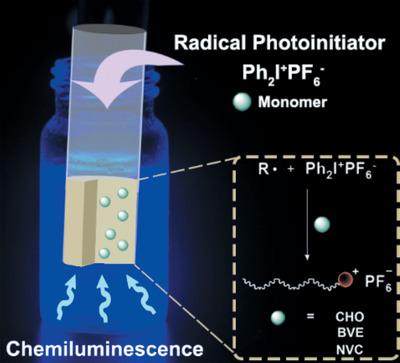当前位置:
X-MOL 学术
›
Macromol. Rapid Commun.
›
论文详情
Our official English website, www.x-mol.net, welcomes your feedback! (Note: you will need to create a separate account there.)
Chemiluminescence-Induced Free Radical-Promoted Cationic Polymerization.
Macromolecular Rapid Communications ( IF 4.6 ) Pub Date : 2020-02-26 , DOI: 10.1002/marc.202000004 Junzhe Zhu 1, 2, 3 , Ye Zhu 1, 2, 3 , Zhiquan Li 1, 2, 3 , Zihang Yu 1, 2, 3 , Xin Guan 3 , Ren Liu 1, 2, 3 , Yusuf Yagci 4, 5
Macromolecular Rapid Communications ( IF 4.6 ) Pub Date : 2020-02-26 , DOI: 10.1002/marc.202000004 Junzhe Zhu 1, 2, 3 , Ye Zhu 1, 2, 3 , Zhiquan Li 1, 2, 3 , Zihang Yu 1, 2, 3 , Xin Guan 3 , Ren Liu 1, 2, 3 , Yusuf Yagci 4, 5
Affiliation

|
Chemiluminescence (CL) has recently been featured as a new external light source for various photoinduced reactions with attractive features such as eliminating continuous energy supply and advanced light source setups. In the present study, the free-radical-promoted cationic polymerization of cyclohexene oxide, n-butyl vinyl ether, and N-vinyl carbazole under CL irradiation is described. The method is based on the visible-light-induced generation of electron donor radicals from bis-(4-methoxybenzoyl)diethyl germane (BAG), bis(2,4,6-trimethylbenzoyl) phenyl phosphinate, and camphorquinone by CL illumination followed by electron transfer to diphenyl iodonium hexafluorophosphate (Ph2 I+ PF6 - ) to form corresponding cations capable of initiating cationic polymerization. The applicability of the process to network formation is also demonstrated by using a bifunctional monomer, tri(ethylene glycol) divinyl ether.
中文翻译:

化学发光诱导的自由基促进的阳离子聚合。
化学发光(CL)最近已成为各种光引发反应的新外部光源,具有吸引人的功能,例如消除了连续供能和先进的光源设置。在本研究中,描述了在CL辐射下自由基促进的环己烯氧化物,正丁基乙烯基醚和N-乙烯基咔唑的阳离子聚合。该方法基于可见光诱导的双-(4-甲氧基苯甲酰基)二乙基锗烷(BAG),双(2,4,6-三甲基苯甲酰基)苯基次膦酸酯和樟脑醌的电子供体自由基的产生,然后进行CL照射电子转移到六氟磷酸二苯基碘鎓(Ph2 I + PF6-)形成相应的阳离子,该阳离子能够引发阳离子聚合。
更新日期:2020-02-26
中文翻译:

化学发光诱导的自由基促进的阳离子聚合。
化学发光(CL)最近已成为各种光引发反应的新外部光源,具有吸引人的功能,例如消除了连续供能和先进的光源设置。在本研究中,描述了在CL辐射下自由基促进的环己烯氧化物,正丁基乙烯基醚和N-乙烯基咔唑的阳离子聚合。该方法基于可见光诱导的双-(4-甲氧基苯甲酰基)二乙基锗烷(BAG),双(2,4,6-三甲基苯甲酰基)苯基次膦酸酯和樟脑醌的电子供体自由基的产生,然后进行CL照射电子转移到六氟磷酸二苯基碘鎓(Ph2 I + PF6-)形成相应的阳离子,该阳离子能够引发阳离子聚合。


























 京公网安备 11010802027423号
京公网安备 11010802027423号